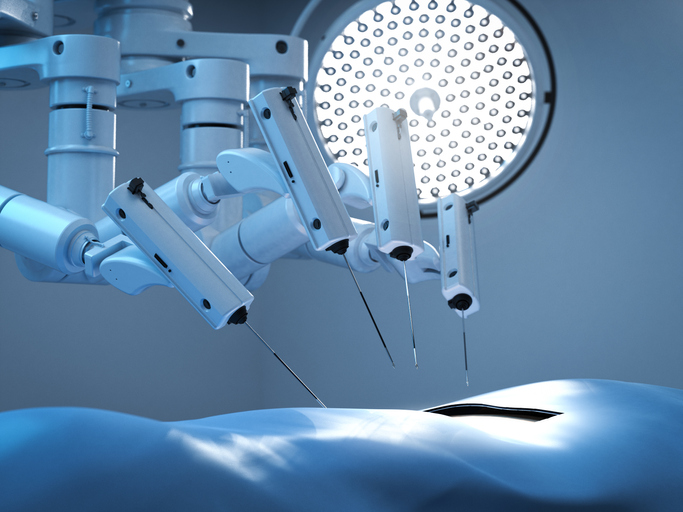
Historically patients with a body mass index (BMI) over 40 could not undergo a kidney transplant surgery due to increased risks, such as the surgeon not being able to see well enough due to the extra girth to ensure successful kidney placement. But robotic surgery may offer a solution.
Currently kidney transplant on heavier set patients require a deeper and larger incision in order to place the kidney. The added distance from the skin to the blood vessels to which the kidney is sewn is farther away from the surgeon’s hand, which makes doing open surgery much more difficult than in a non-obese abdomen. All this makes the risk of complications much higher in the morbidly obese, than those that are not, said Dr. Thomas Pshak, a surgeon with the UCHealth Transplant Center and an expert in robotic kidney transplants.
Infection is also a big problem in morbidly obese patients because the incision is under the abdominal pannus, he added. Thus, the incision has a hard time healing and easily becomes infected because it is under this large skin fold and it is difficult to keep dry.
Patients like these who did make it on a transplant list were often overlooked, due to their risk factor, Pshak said.
Unlike open surgery, robotic kidney transplants can safely be done on patients over a BMI of 40, opening the door previously closed to such patients, according to Pshak. As of February 8, UCHealth University of Colorado Hospital on the Anschutz Medical Campus performed two successful robotic kidney transplants on patients with over 40 BMI, according to a press release. Pshak is the lead on the robotic kidney transplant team.
“We want to be able to offer anyone eligible for transplant to have the opportunity because we know they will live longer and their quality of life will be better,” Pshak said. “The benefits of the transplant far outweigh the risks. So finding a way to transplant anyone who wants it regardless of their weight is the key message and to give people that want a transplant a hope that that can happen.”

A Deep-dive Into Specialty Pharma
A specialty drug is a class of prescription medications used to treat complex, chronic or rare medical conditions. Although this classification was originally intended to define the treatment of rare, also termed “orphan” diseases, affecting fewer than 200,000 people in the US, more recently, specialty drugs have emerged as the cornerstone of treatment for chronic and complex diseases such as cancer, autoimmune conditions, diabetes, hepatitis C, and HIV/AIDS.
With robotic kidney transplant surgery, a two-and-a-half inch-incision is made near the belly button as well as three smaller incisions for the robotic arms and one for the camera. The less invasive nature of the robotic surgery compared to open surgery – the current standard of care – means patients often do not need narcotics afterwards, Pshak said. Moreover, the less invasive method decreases the post surgery wound risks associated with open surgery. He added that, on a three year timeline, the efficacy of robotic kidney transplant surgery is comparable to open surgery, both in terms of the graft working as well as patient survival, Pshak noted.
The surgery has worked for patients up to a BMI of 60, Pshak said, increasing access to larger patients.
However, UCHealth is only the fourth hospital to offer robotic kidney transplants. University of Illinois at Chicago, Cleveland Clinic, and Henry Ford Hospital in Detroit also offer the robotic surgery. In fact Cleveland Clinic was the first hospital to do so back in 2019.
UCHealth offers patients west of the Mississippi access to robotic surgery. Previously patients seeking robotic kidney transplants would have to travel east, limiting access for many, Pshak said. UCHealth uses Intuitive Surgical’s DaVinci Robot, Xi.
So if robotic kidney transplant surgery works just as well as open surgery and can be done on a group of patients previously ineligible due to elevated BMI, why aren’t more hospitals and surgeons offering it? There is a steep learning curve to learning how to use the robot, Pshak said. Surgeons who are adept at performing an open surgery for kidney transplant often express reluctance to learn a new method, especially given the steep learning curve and the fear that they might not be good at robotic transplant surgery initially. Further, robotic surgery is not currently a requirement of either residency or fellowship programs, so not all new surgeons have the initial training either, Pshak added.
“It is well established there is a learning curve, even when using the robot in simple cases. and in kidney transplant it is probably one of the more complicated cases you can do because you are sewing up major blood vessels with tiny sutures and you can’t feel what you are doing and so a lot of transplant surgery is based off of what your hands are feeling and how tight you are pulling a suture and what the tension feels like. With the robot you don’t have that,” Pshak said. “You rely on visual cues and experience to know how hard you can pull on something before it tears. and so that is a huge learning curve that is a big factor in why this hasn’t taken off yet.”
However, the new generation of surgeons may have a hand over the older surgeons: video games. Not only do some residency programs offer robotics training, but an increasing number of residents play video games compared to a few decades ago.
“A lot of younger surgeons now that are coming out of residence are getting more and more robotics training in their residency,” Pshak said. “This younger generation is used to video games and doing more on the robot. That may be the next wave of this really taking off.”
Photo: PhonlamaiPhoto, Getty Images












